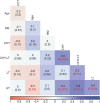Recent increase in low complexity polygenomic infections and sialic acid-independent invasion pathways in Plasmodium falciparum from Western Gambia
- PMID: 37653544
- PMCID: PMC10472613
- DOI: 10.1186/s13071-023-05929-4
Recent increase in low complexity polygenomic infections and sialic acid-independent invasion pathways in Plasmodium falciparum from Western Gambia
Abstract
Background: The malaria parasite Plasmodium falciparum utilizes multiple alternative receptor-ligand interactions for the invasion of human erythrocytes. While some P. falciparum clones make use of sialic acid (SA) residues on the surface of the human glycophorin receptors to invade the erythrocyte, others use alternative receptors independent of sialic acid residues. We hypothesized that over the years, intensified malaria control interventions and declining prevalence in The Gambia have resulted in a selection of parasites with a dominant invasion pathways and ligand expression profiles.
Methods: Blood samples were collected from 65 malaria-infected participants with uncomplicated malaria across 3 years (2015, 2016, and 2021). Genetic diversity was determined by genotyping the merozoite surface protein 2 (msp2) polymorphic gene of P. falciparum. Erythrocyte invasion phenotypes were determined using neuraminidase, trypsin, and chymotrypsin enzymes, known to cleave different receptors from the surface of the erythrocyte. Schizont-stage transcript levels were obtained for a panel of 6 P. falciparum invasion ligand genes (eba175, eba181, Rh2b, Rh4, Rh5, and clag2) using 48 successfully cultured isolates.
Results: Though the allelic heterozygosity of msp2 repeat region decreased as expected with reduced transmission, there was an increase in infections with more than a single msp2 allelotype from 2015 to 2021. The invasion phenotypes of these isolates were mostly SA independent with a continuous increase from 2015 to 2021. Isolates from 2021 were highly inhibited by chymotrypsin treatment compared to isolates from 2015 and 2016. Higher invasion inhibition for 2021 isolates was further obtained following erythrocyte treatment with a combination of chymotrypsin and trypsin. The transcript levels of invasion ligand genes varied across years. However, levels of clag2, a rhoptry-associated protein, were higher in 2015 and 2016 isolates than in 2021 isolates, while Rh5 levels were higher in 2021 compared to other years.
Conclusions: Overall, these findings suggest increasing mixed infections with an increase in the use of sialic-acid independent invasion pathways by P. falciparum clinical isolates in the Western part of Gambia.
Keywords: Erythrocyte; Expression; Inhibition; Invasion; Ligand genes; Malaria; P. falciparum.
© 2023. BioMed Central Ltd., part of Springer Nature.
Conflict of interest statement
The authors declare that they have no competing interests.
Figures





References
-
- Gaur D, Mayer DCG, Miller LH. Parasite ligand-host receptor interactions during invasion of erythrocytes by Plasmodium merozoites. Int J Parasitol. 2004;34:1413–1429. - PubMed
-
- Gilberger T-W, Thompson JK, Triglia T, Good RT, Duraisingh MT, Cowman AF. A novel erythrocyte binding antigen-175 paralogue from Plasmodium falciparum defines a new trypsin-resistant receptor on human erythrocytes. J Biol Chem. 2003;278:14480–14486. - PubMed
-
- Narum DL, Fuhrmann SR, Luu T, Sim BKL. A novel Plasmodium falciparum erythrocyte binding protein-2 (EBP2/BAEBL) involved in erythrocyte receptor binding. Mol Biochem Parasitol. 2002;119:159–168. - PubMed
MeSH terms
Substances
Grants and funding
LinkOut - more resources
Full Text Sources

